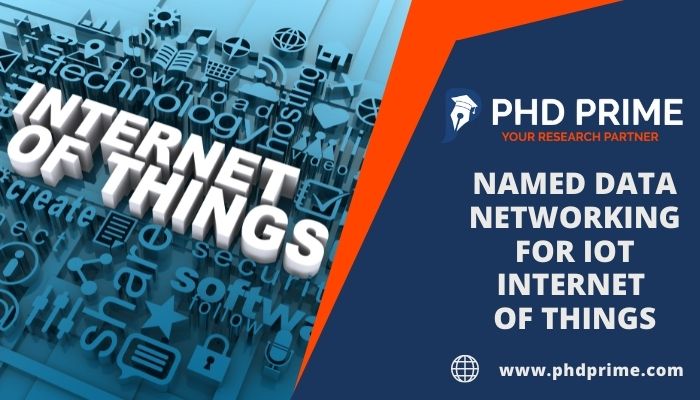Named Data Networking (NDN) are a feature of the next-generation internet and network infrastructure that enables the scalability of content management, movement, privacy, and reliability, and also provides accessibility of data regardless of its location. This article will provide you with a complete picture of named data networking for IoT applications. Let us first start with the basic understanding of NDN supports for IoT .

How does NDN support IoT?
- The NDN, formerly known as content-centric networking (CCN), has indeed been proposed as a solution to a variety of Internet of Things (IoT) constraints
- It also comes with the ability to surpass the present IP model in several ways
- The IP conceptual framework is burdened further by the demands and problems of the Internet of Things architecture
- It is also enforced by limits like low memory and computing capability
- While it also mandates better energy efficiency in the context of unpredictable data connections
- The CCN and NDN named contents, in-network caching, as well as named-based route approaches offer viable options for overcoming these limitations and demonstrating alternate deployments
In this way, Named Data Networking supports the internet of things. We have been working with NDN and IoT combinations since their origin. The research and development team with us is highly capable of designing appropriate infrastructure using Named Data Networking for IoT. In this regard, we provide the architecture of NDN – IoT systems below.
NDN – IoT Architecture
Prominently the internets of things applications include smart grid, smart cities, home automation, and smart healthcare systems. Whatever is the application the basic architecture of NDN – IoT systems remain the same
- Naming in different planes form the basic functioning
- Management and control plane
- Aggregation – unicast faces, Intra Node Protocol or INP and Forwarding Service
- Name – Centric Service – Alias service and Configuration files
- Controlled flooding
- Data plane (using PIT, FIB, and CS)
- Caching strategy – pCASTING and Caching Utility Function
- Forwarding strategy – Adaptive Interest Forwarding or AIF
- Management and control plane
These are the IoT – NDN components that find applications in a variety of devices including cars, computers, wireless connections, printers, scanners, and all home appliances. With many successful IoT project completions, we have gained exceptional field knowledge and Research experts are ready to share them with you to support you in your project. Let us now look into the important elements of NDN
Major elements of NDN
The important components of named data networking structure are different from different points or perspectives
- User side perspective
- Data exchange (within the data name)
- congestion signal (no timeout conclusions)
- Location control (supporting libraries and applications)
- RTO updating algorithm (no conclusion is obtained)
- From the perspective of providers
- Fine-grained traffic matrix and optimal link weight (using flexible forwarding mechanism to ease the connection)
- More flexibility and reduced overhead
- The impact of overlay routing is greater than IP based internet
- In the view of routers (hop by hop control)
- Control mechanisms
- Scheduling the interest packets and queue management in the network layer
- Forwarding and routing mechanism in strategy and network layer
- Feedback mechanisms
- Probing interest packets and NACK packets in the strategy layer
- Backpressure in data link layer
- Location control
- Network, strategy, and data link layer
- Control mechanisms
In order to get a complete understanding of various perspectives and the related NDN components, get in touch with our expert team. Let us now have a look into a taxonomy of Named Data Networking for IoT infrastructure
Taxonomy of NDN based IoT
The internet of things functionality based on Named Data Networking consists of the following aspects
- In-network caching management
- Timer-based (LFF and push-based)
- Device (probabilistic and router dependent)
- Consumer (tag assisted, popularity and freshness aware and PCS)
- Hybrid (SLA)
- Access control
- Attribute-based (consumer, identity, and capability-based)
- Role-based (based on application, policy enforcement, and NDOMUS AC)
- Aggregation of data
- Push based and aggregation service
- Communication among multiple sources and SPDP service aggregation
- NDN – VIN
- Data and device naming
- Semantics (functional oriented and tag assisted naming)
- Hierarchical (Native, Homenet, NDOMUS, PHINet, NDN – SH, NDN – BMS, NBS native naming)
- Multiple (device and location-based)
- Routing and forwarding strategy
- Location (based on geographic position and location information)
- Naming (device-driven functional and policy-based – homenet and NDN – BMS forwarding)
- Directed forwarding (Cache aware, link recovery, hierarchical routing, and dd – NDN)
- Adaptive forwarding (context-aware, scheduler based, and AIF)
- Heuristic forwarding (probability-based)
- Discovery and device configuration
- Centralized (fixture pairing, auto-configuration, network discovery, namespace based configuration, and LASeR)
- Decentralized (auto-node)
- Service registration and discovery (ICWSAN, NSP, SPDP, NDNe, and semantic-based)
The Named Data Networking for IoT functionalities can be better understood using the real-time implemented projects. So for a complete picture of the taxonomy, structure, and working of NDN – IoT you can reach out to us at any time.
Since NDN is such a new field of study, there is a lot of room for technological advances to be developed. Nonetheless, applications for diverse network contexts are needed to investigate NDN advantages like multicast, in-network caching, smart and stateful forwarding, scaling, and the ease with which applications can be developed and deployed. In this respect, the following research areas in IoT gains significance in NDN
Important Research Areas in Named Data Networking for IoT Internet of Things
- Increasing the storage capacity (cache capacity)
- Dissemination and management of security problems related to keys
- Routing table scalability issues due to and bound addresses (management of routing table)
For significant and benchmarking references related to these topics of research, you can surely get our support. We are sought by researchers from all parts of the world for our ultimate research guidance including topic Selection, paper publication, writing codes and algorithms, and many other aspects. Let us now talk about privacy in NDN – IoT
Security and privacy of NDN in IoT
Content properties are clearly provided in NDN because it works directly with content names (CNs). As a result, as stated earlier, content safety and confidentiality are challenging issues. We have provided comprehensive data about the safety and privacy of NDN in IoT in the following.
- Network layer
- Congestion outrage (NDN forwarding rate constraint characteristics)
- Prefix hijack black hole (NDN communication symmetric nature)
- Cache snooping
- Physical and data link layer
- Network sniffing and man in the middle attack (NDN encryption of both name and content)
- Strategy layer
- Object Discovery attack (cached data delay in forwarding, exclusion filter disabling, and name prefix limitation)
- Cache monitoring attack (tunneling mechanism, unpredictable content name, and disabled scope field of interest packets)
- Flow cloning attack (content name encryption)
- Application layer
- DoS attacks
- Interest flooding (tracking unsatisfied interest packets)
- Poisoning cache and content (ranking and authentication of content)
- Cache pollution (selective catching and tunneling – selective countermeasures, disabling hop count, and adding cached data delay – naive countermeasures)
- Scanning attack(scanning all the names is quite difficult)
- DDoS attacks
- Early-stage interest flooding detection (Poseidon)
- Dynamic content interest flooding (interest cash)
- Interest flooding (mitigating attacks intelligently, satisfaction based pushback and interest acceptance, token bucket pair interface fairness, broadcast and FIB based interest flooding)
- DoS attacks
We have proposed innovative and reliable technical solutions for solving these issues pertaining to different layers of Named Data Networking for IoT projects. Get in touch with us to know more details on how we handled these issues efficiently. Let us now talk in detail about the security schemes involved in IoT design.
Security schemes for IoT
- Vital management
- Encryption utilizing CN-associated keys
- Access control with key production, dissemination, and revoking
- Controlling Access
- Access control techniques, such as the development of access control rules/policies to cached data, and verification
- Management of trust
- NDN’s Trust Management
- Designing and creating viable techniques for managing user trust
Three main types of trust models have been studied in the following
- Hierarchical trust model
- A key namespace authorizes the use of keys in a hierarchical trust paradigm
- Because it is certified by a private entity and this public key is used to certify relevant information, a data packet containing a public key is essentially a certification
- Lightweight IoT trust
- The NDN trust framework is designed on asymmetric cryptography
- It would be impractical for IoT devices with limited resources
- Web of trust model
- To enable safe interaction without the need for pre-agreed trust anchors, a web of trust is used
Furthermore, while all intermediate nodes in between user nodes and the service provider have access to the customer’s information requirements, an intruder can trace private data. Finally, protection, information protection, and security remain unexplored areas in NDN. Other security solutions are as follow,
- Authorizing application and symmetric authentication
- Providing trust model, encryption, and access control scheme
- Hybrid, pull, and push-based dissemination
- Updating auto-configuration and data-based security
- Managing user privilege and vital distribution services
Your search for reliable information on such security methods might become hard as hardly any authentic research and implementation data are available on these. So in order to have access to benchmark references from top research iot journals you can really reach out to us. Let us now look into Named Data Networking for IoT simulation
Simulation analysis of NDN and IoT
- It seems the system must assess under a variety of conditions
- Because the Internet of Things is dynamic, the adaptability must be handled with caution
- With this in mind, we’ve compiled a list of a few reliable options for simulation. Connect with us to have access to them
- The following operating systems are supported for NDN and IoT
- TinyOS and FreeRTOS
- RIOT and Contiki
- OpenWSN
Simulation plays a key role in any project related to IoT, as performance analysis beforehand entails the research to the next level. Let us now talk about NDN supports for various platforms of IoT.
NDN supports for IoT platforms
- NDN on Arduino
- Arduino minimal app is the necessity
- RIOT OS
- It is a friendly operating system for IoT
- NDN RIOT is under development
- NDN – IoT
- Toolkit for developing NDN on Raspberry Pi
- Easy mechanisms for service discovery
Apart from the above platform, we gained enough potential to work on any advanced architecture. Our technical experts are here to offer you complete support on all project topics related to NDN – IoT. Let us now talk about the various IoT testing scenarios.
Testing scenarios for IoT
The following are the major simulation or testing scenarios for the internet of things projects
- Scenario specific to application purposes
- Based on the segmentation of network at changing distances
- Area of deployment – small and large scale
- Network topologies involved – mesh and circle
In recent times, we have delivered a series of successful projects of IoT simulation. Get in touch with us to know the different testing scenarios that we worked in and also you can get all your doubts related to it cleared from our research experts. For a detailed insight into Named Data Networking for IoT System let us have a look into a case study.
Case studies for NDN and IoT
This is a case study of NDN and IoT on Building Management Systems or BMS
- A primary building management system deployed on the campus
- Spread over several buildings
- Several sensors are included (both wired and wireless)
- Characteristics of data production
- Sensors with limitations on storage
- Huge quantities of information or handled based on water flow, humidity, quality of air, electricity, lighting, and temperature
- Patterns followed in data consumption
- Both real-time and previous data are recorded
- Various data subsets are also included
- Data at multiple frequencies are to be accessed by the devices
Similar to the above scenarios, NDN is used for many more real-time implementations. In order to better understand the working of NDN-based internet of things applications, we will provide a better comparative analysis on various successfully implemented projects of ours. Let us now have a look into the parameters for evaluation of various network models in NDN IoT,
Important Parameters for Network Model
- Size of storage of content
- Cache utilization and its hit ratio
- Delay in playback and startup
- Throughput gain and success probability
- Deal for an interest packet
- Interest packets satisfaction rate
We highly insist upon obtaining the most perfect results with respect to these parameters and as a result, we have registered huge success in all projects of Named Data Networking for IoT that we guided to date. We emphasize the need of conducting an extensive study in order to turn fresh ideas into reality. We will provide institutional and professional project support. Reach out to us at any time to get the advice of world-class certified research experts.





















